
The Winter Palace is a former imperial residence and a striking monument of the Baroque style, located in the center of St. Petersburg.
The Winter Palace is the largest and one of the most famous palaces not only in Russia, but also in Europe.
Today, the Winter Palace is included in the museum complex of the State Hermitage Museum and the main exposition of the Hermitage is located within its walls and in the adjacent neighboring buildings.
The current building of the Winter Palace was built in 1754-1762, commissioned by the Empress Elizabeth Petrovna by the architect of Italian origin Francesco Bartolomeo Rastrelli.
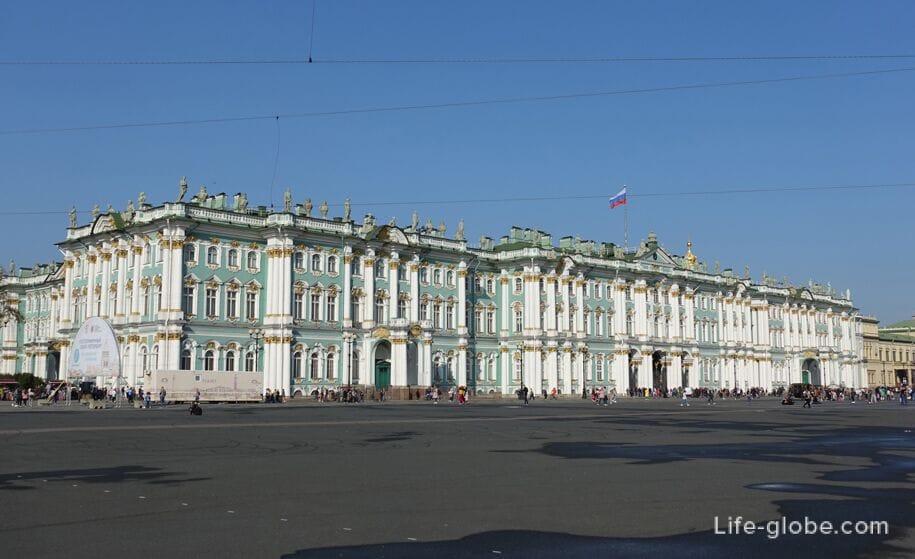
In total, during the history, before the construction of the monumental Winter Palace near the waters of the Neva River, there were four more royal residences, which in different periods were located on different sites in the city:
- initially, Peter I settled in a small one-story summer house built in a hurry in 1703, located near the Peter and Paul Fortress (today the building is known as the House of Peter I);
- later, the construction of the Winter Palace of Peter Ibegan, on the site of which is now located The Hermitage Theater. This palace has undergone several reconstructions and restorations. In 1725, Peter I died in this palace.;
- the heiress-Empress Anna Ioannovna considered the Winter Palace too small and ordered the construction of new chambers. In 1735, the construction of the palace was completed, and Anna Ioannovna moved into it. After the palace was expanded, until it was decided to erect a completely new building in the same architectural style and already more monumental-the current Winter Palace;
- another, temporary palace, was built in 1755. The palace was built by Rastrelli during the construction of the new (main) Winter Palace. The palace was located on the corner of Nevsky Prospekt and the Moika River embankment. The palace was dismantled in 1762. After that, on the site of the temporary Winter Palace, a house was erected-the Chicherin Palace, which during the history also belonged to the Eliseev family. Today, the house is home to the Talion Imperial Club Hotel, and tours of the historic halls of the former mansion are conducted. Read more about the house of Chicherin (Yeliseyevs)...
The construction of the Winter Palace lasted eight years, which fell on the decline of the reign of Elizabeth Petrovna and the brief reign of Peter III. In the autumn of 1763, Catherine II became the sovereign mistress of the Winter Palace.
For more than 150 years, the palace was the main ceremonial imperial residence of Russia.
During the revolution, in February 1917, the palace was occupied by troops who defected to the rebels. Later, the royal family of the Romanov dynasty was taken to Yekaterinburg, where they were shot.
From July 1917, the palace became the seat of the Provisional Government.
During the revolution, on the night of October 25-26 (November 7-8, new style), 1917, the Winter Palace was stormed by the Red Guards and revolutionary units of the army and Navy. A memorial plaque placed on the western facade of the Winter Palace commemorates this event.
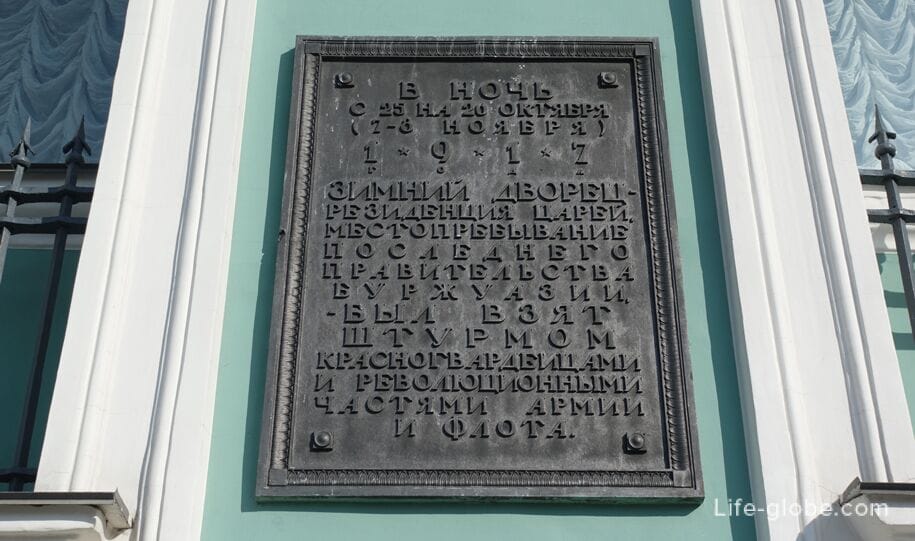
In November 1917, the palace was declared a museum. The expositions located in the palace represent the state halls and royal apartments, collections of antiquities of Eurasia and the East, as well as collections of paintings, sculptures and decorative arts of Europe and the East.
During the war, the palace building was damaged, after a long restoration procedure began.
Today, the Winter Palace is an outstanding architectural monument, and the main exposition of the State Hermitage Museum is located within its walls.
The Winter Palace is located in the very center of St. Petersburg - between the Palace Square and the Palace Embankment of the Neva River.
The building is a brilliant example of the synthesis of architecture and decorative plastics.
The three-storey building of the palace in the plan has the form of a square of 4 wings with an inner courtyard and the main facades facing the Neva River, the Admiralty building and the Palace Square.
The grandeur of the building is given by the magnificent decoration of the facades.
All the facades of the palace are decorated with a two-tiered colonnade with capitals, numerous statues and vases on the roof. The abundance of stucco decorations on the facades of the palace, made in the form of cornices and window frames, mascarons, cartouches and rocailles, torn pediments-create not only a rich play of light and shadow, but also give the overall appearance of the building a special splendor and grandeur.
The main and most solemn is the southern facade of the Winter Palace-it faces the Palace Square and through the portals of this facade is the entrance to the Hermitage Museum.
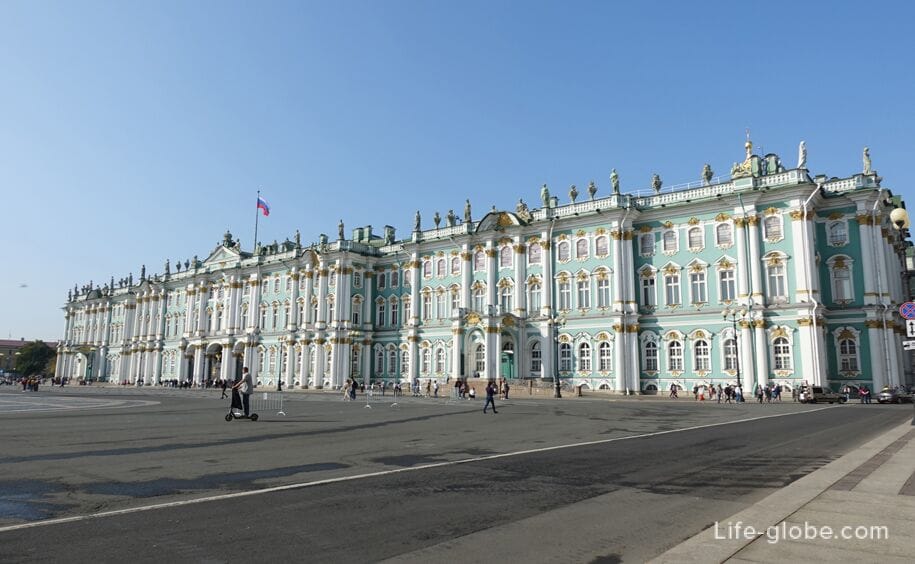
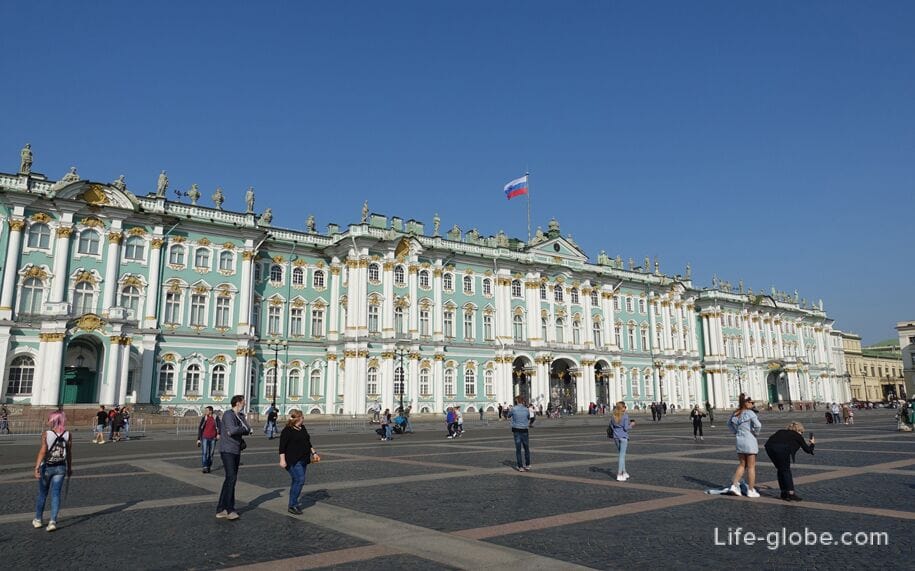
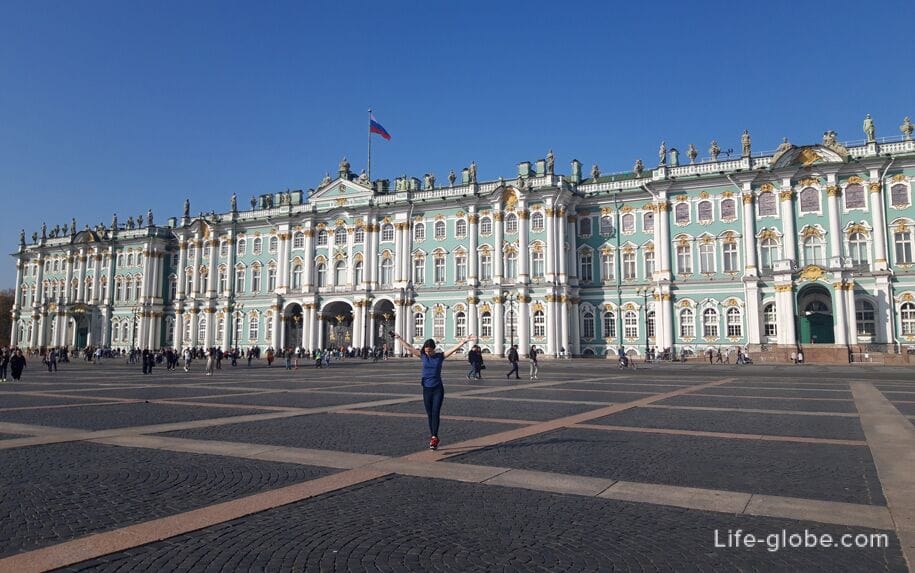
The southern facade has three parts, the main and most beautiful of which is the central one. The central part of the facade is cut through by three arches, including the main passage to the courtyard, accentuated by the verticals of paired columns.
Main Portal
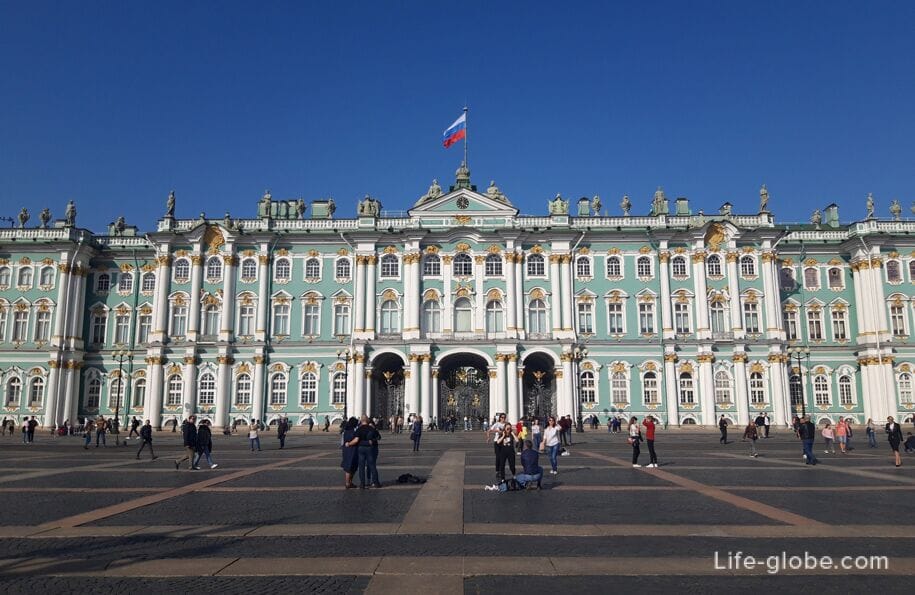
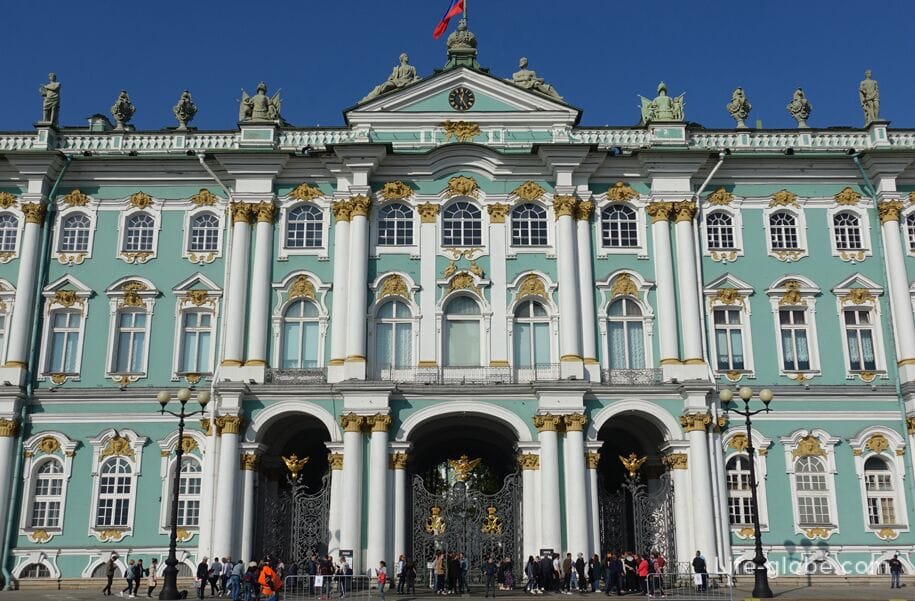
Eastern Portal

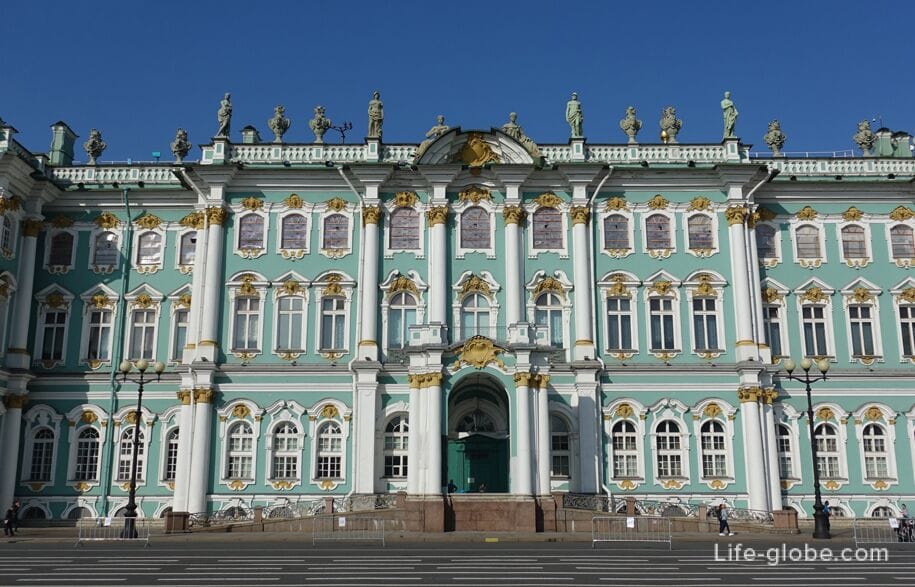
Western Portal
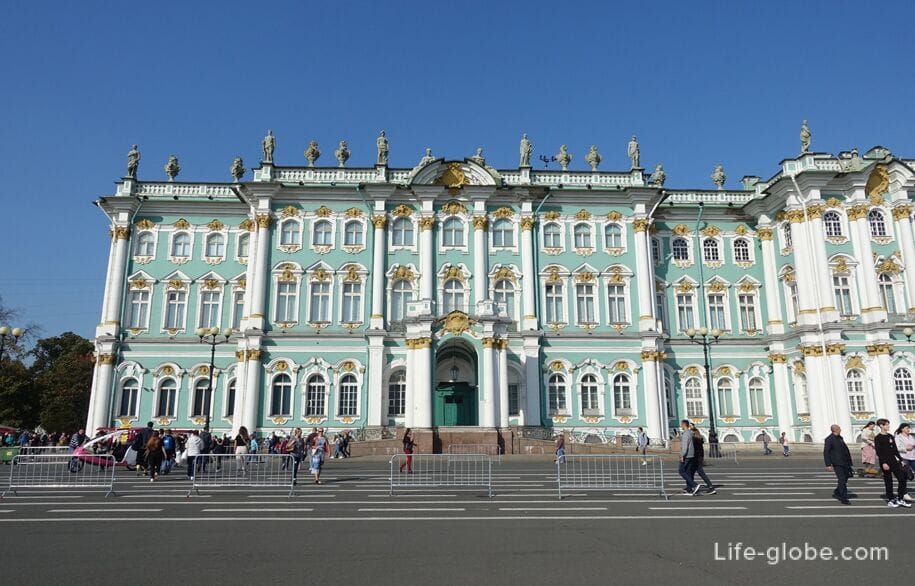
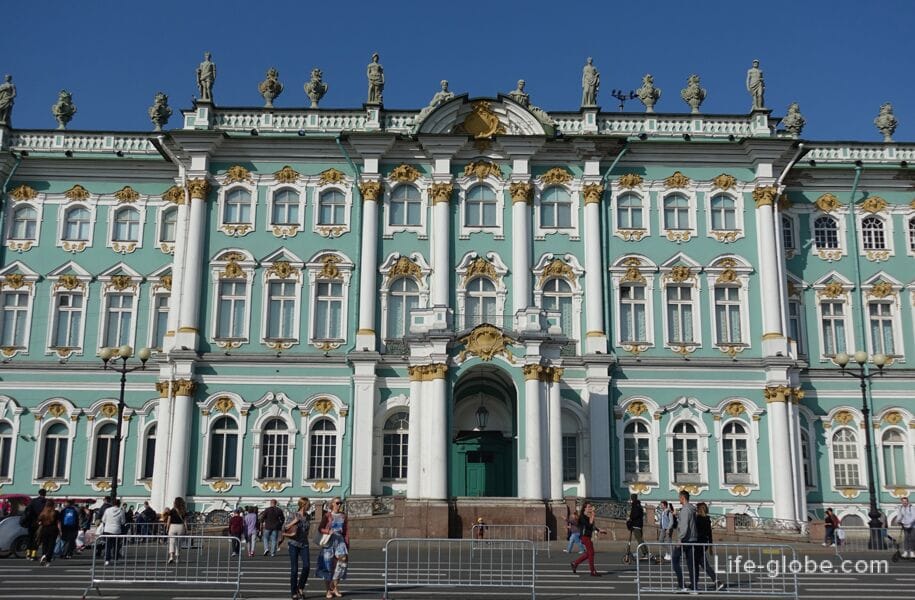
The northern facade of the Winter Palace faces the Neva River and faces the Palace Embankment.
This facade is as majestic as the southern one. It gives the impression of an endless colonnade, which, when viewed from afar, gives the facade of the palace lightness and airiness.
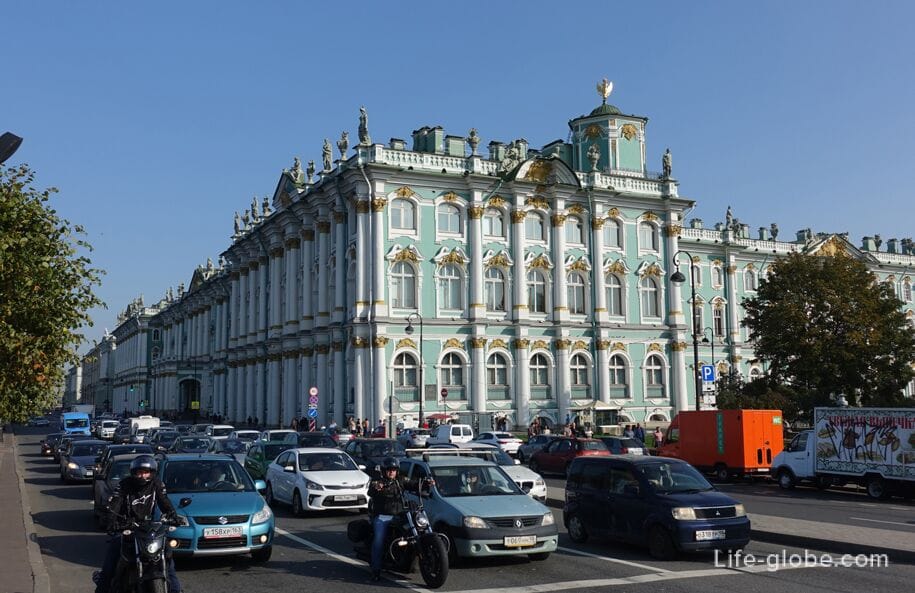
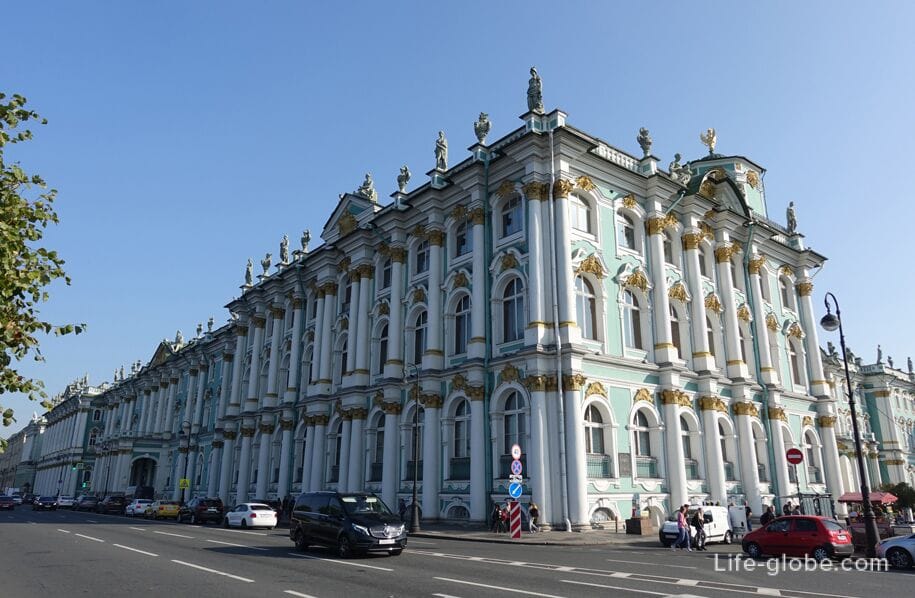

The western facade of the palace faces the small garden of the Winter Palace and "looks" at The Admiralty. This facade resembles the composition of a country palace.
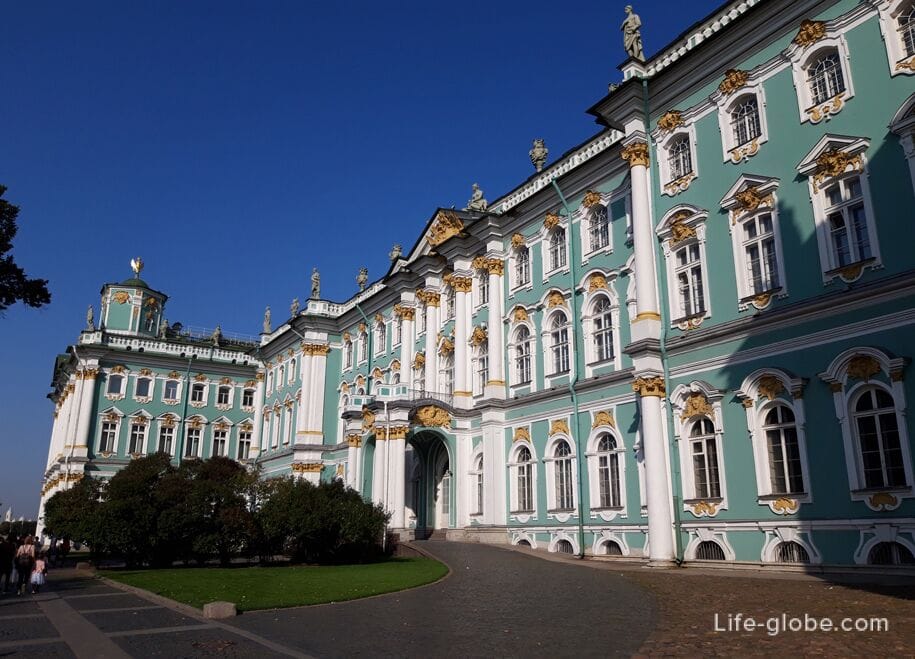
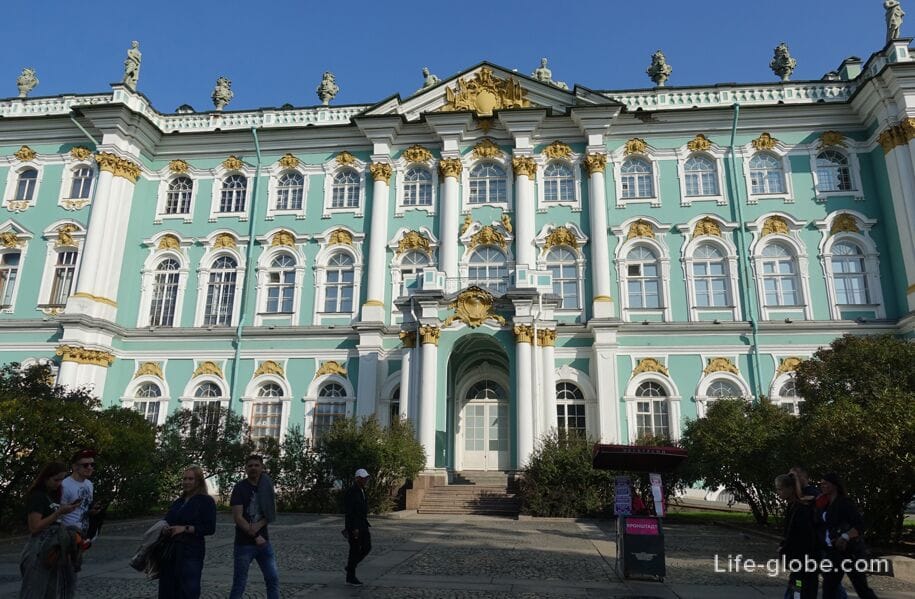

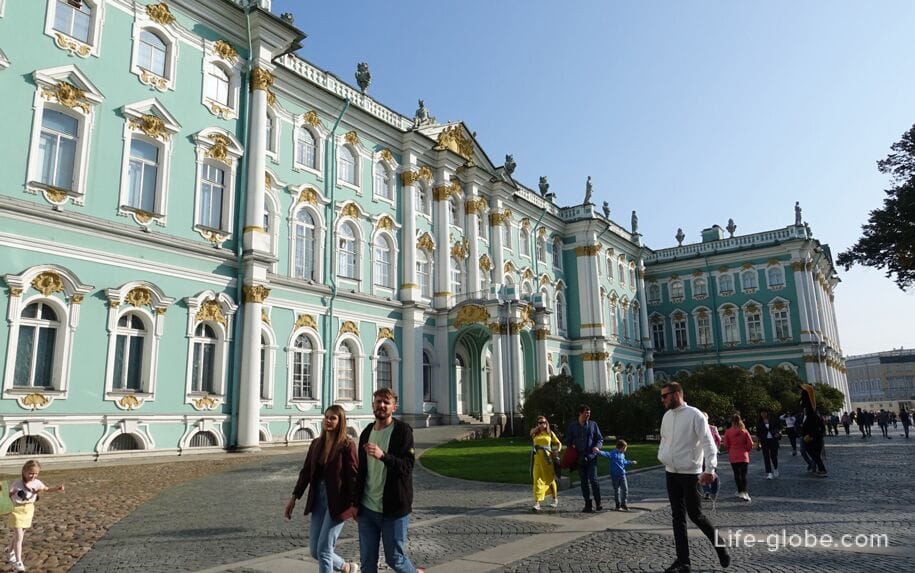
The eastern facade faces Millionnaya Street and has massive side buildings.
This facade is connected by covered archways with buildings that are also part of the State Hermitage Museum complex (The Small Hermitage, The New Hermitage, the Great Old Hermitage, the Winter Palace of Peter the Great and the Hermitage Theater).
View from Palace Square/Millionnaya Street on the arch-the transition from the Winter Palace (left) to the Small Hermitage (right)
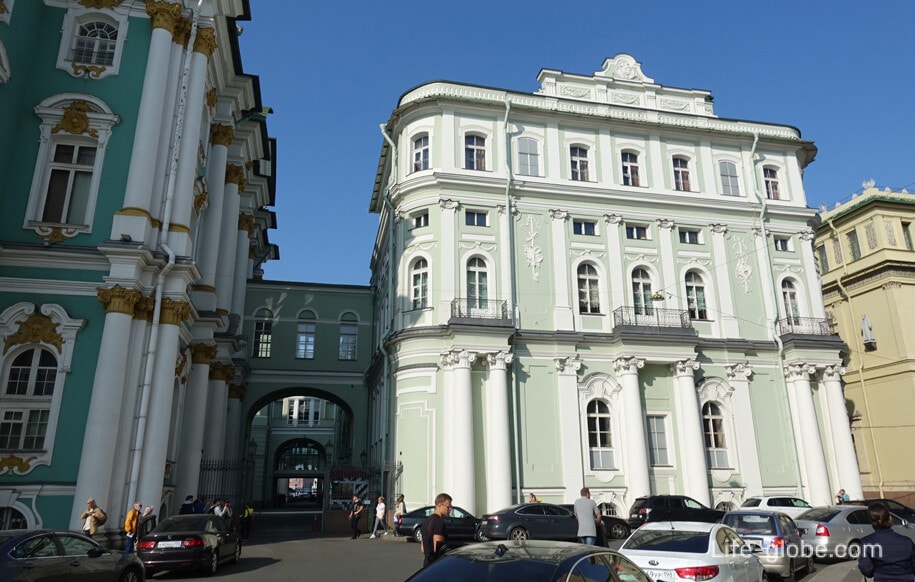
View from the Palace Embankment to the Small Hermitage (in the center) and the arches-transitions to the Winter Palace (on the right) and to the Big (old) The Hermitage Museum (left)

The expositions of the State Hermitage Museum, located in the Winter Palace, represent recreated state halls and apartments of the royal family, contain collections of antiquities of Eurasia and the East, as well as a collection of paintings, sculptures and decorative arts of Europe and the East.
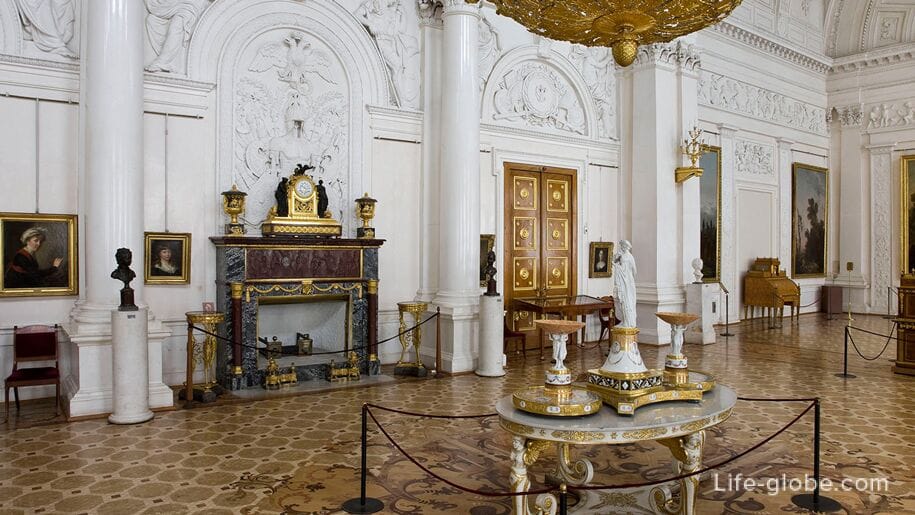
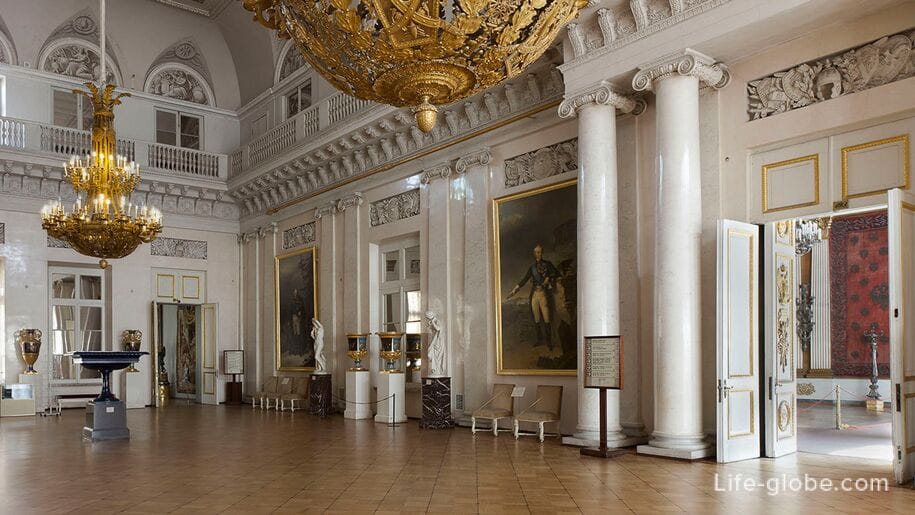
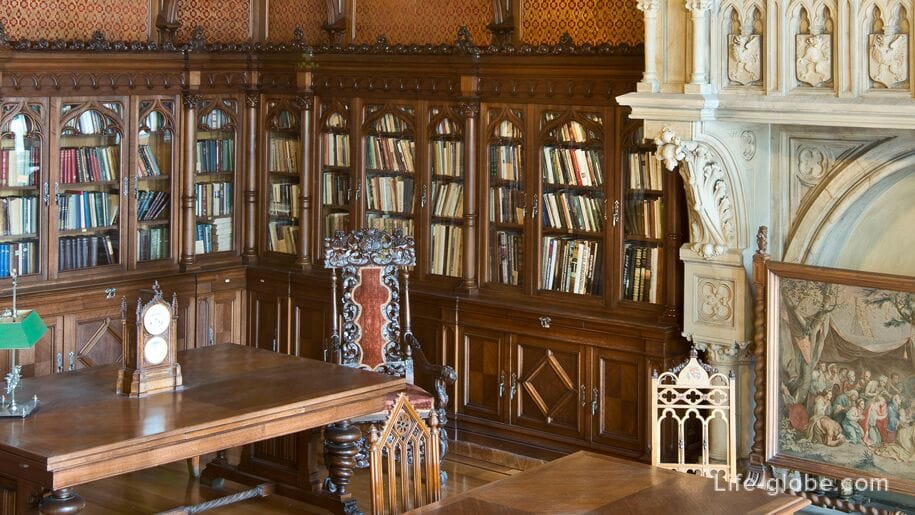
Rooms and halls of the Winter Palace:
- The Jordan Staircase (the pearl of the Winter Palace) is a masterpiece of architectural art. On this ladder, during the feast of the Epiphany, a procession descended to the Neva River, where an ice hole - the Jordan-was cut in the ice to consecrate the water;

- Grand Throne (St. George's) Hall;
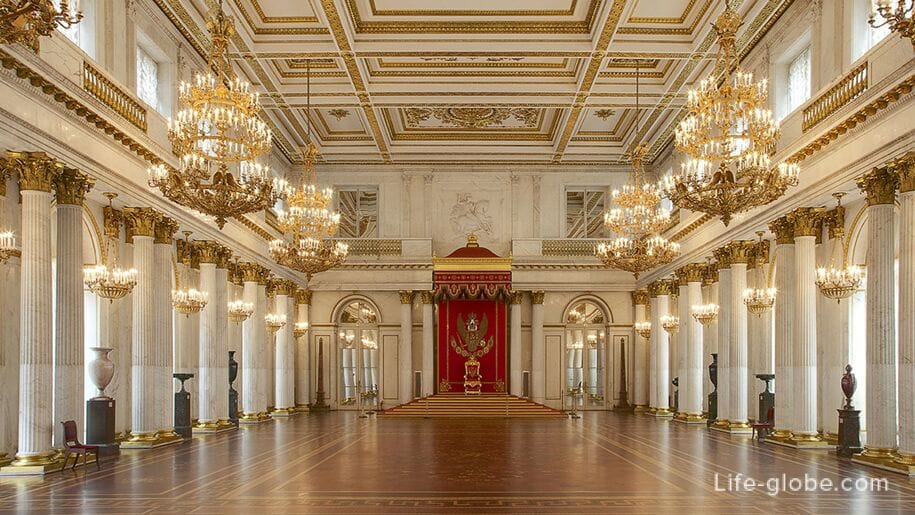
- The malachite drawing room, which was part of the private chambers of the wife of Nicholas I-Alexandra Feodorovna as a formal living room;
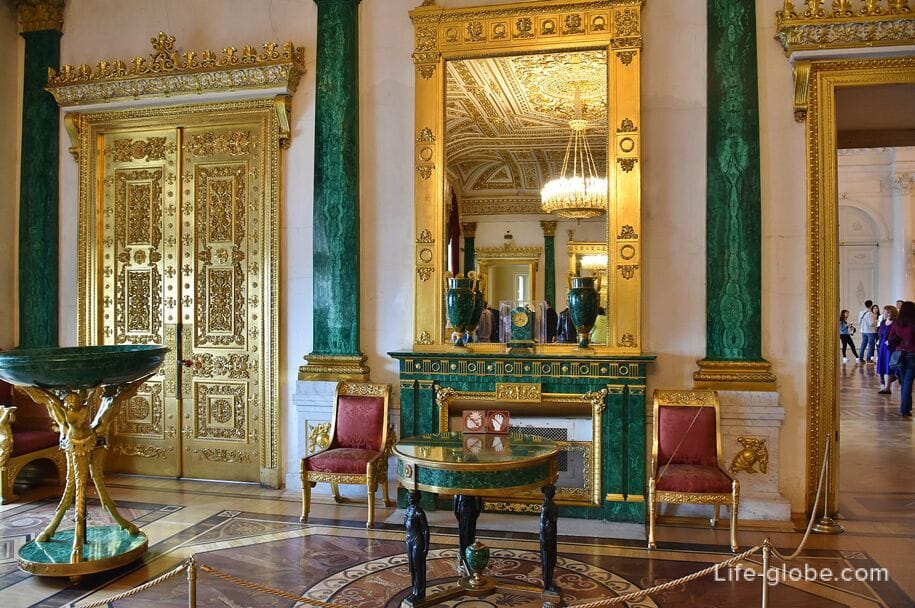
- Petrovsky (Small Throne) Hall-dedicated to the memory of Peter I. The throne in the hall is a copy of the throne of the Empress Anna Ioannovna, made in the late 18th century;
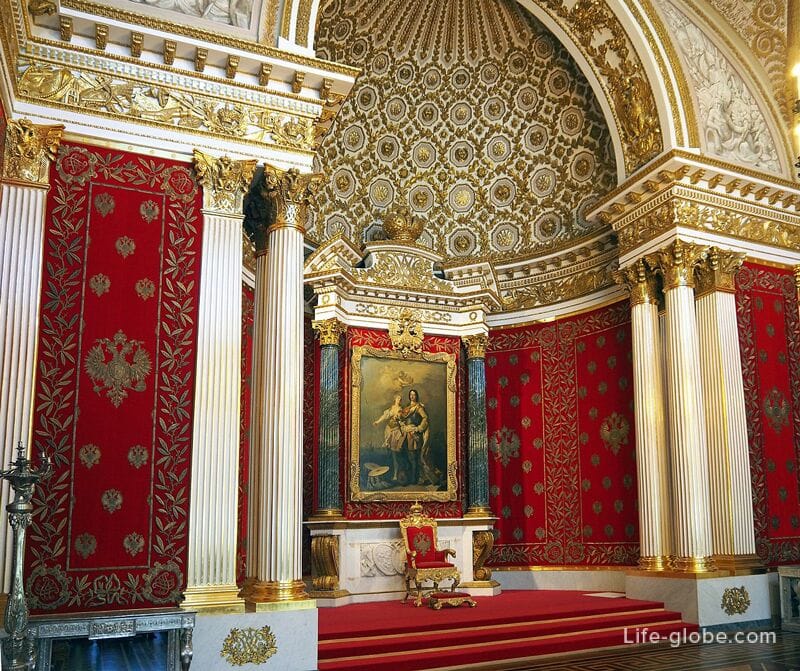
- Coat of Arms Hall-recreated by V. P. Stasov after the fire of 1837 for solemn ceremonies in the style of late Russian classicism;
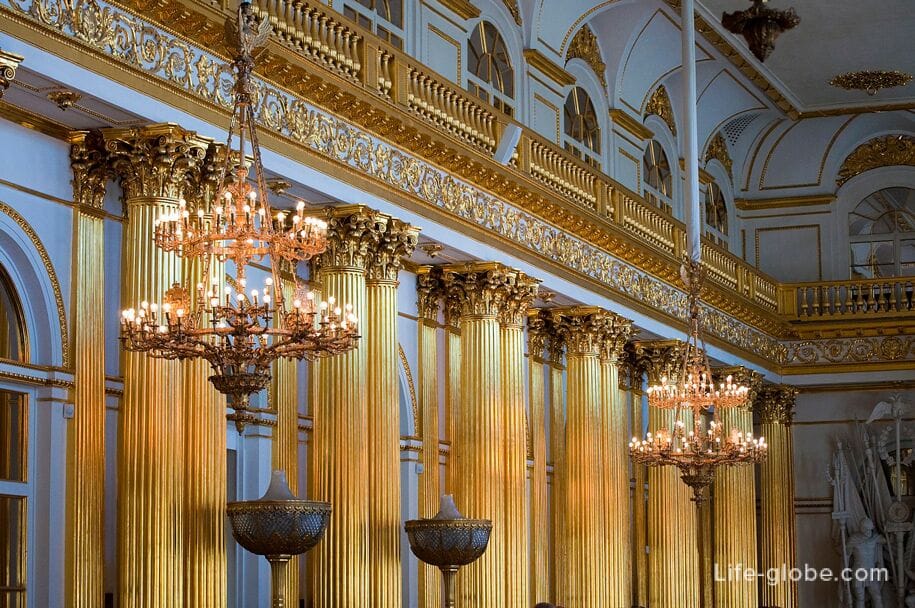
- Picket Hall, created in 1839 by V. P. Stasov to the south of the Coat of Arms Hall on the site of two small rooms and a staircase. The hall was used for the divorce of the military guard of the company of the palace grenadiers of the picket, hence the name of the hall. The hall housed the museum collections of the Oriental Department, carpets and other art objects;
- Military Gallery of 1812, dedicated to the victory of Russian weapons over Napoleon;

- Alexander Hall, which, according to the plan, was supposed to perpetuate the memory of the Emperor Alexander I. Currently, the hall exhibits a collection of Western European silver from the 17th and 18th centuries;
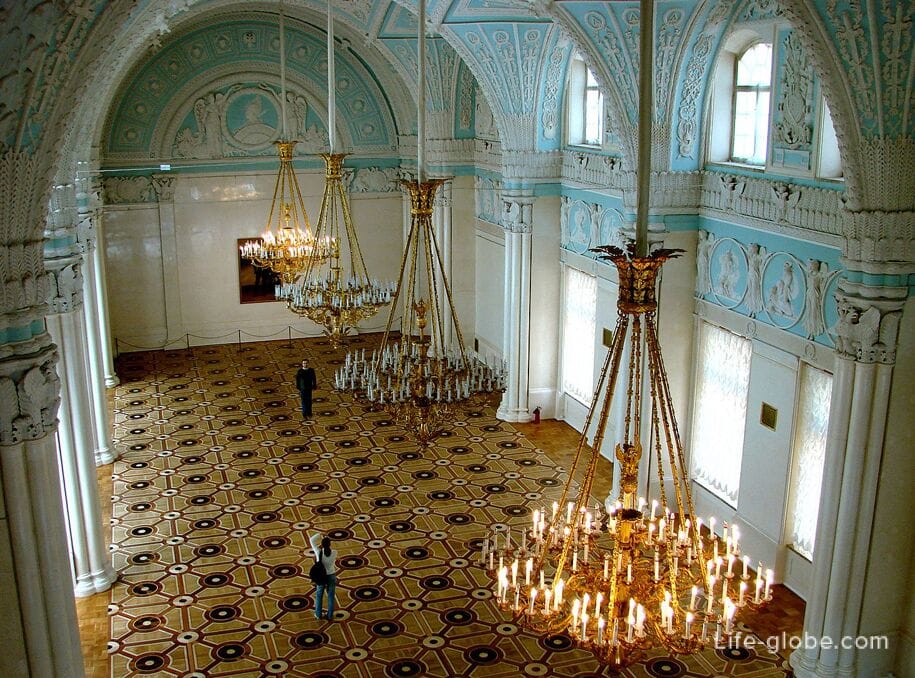
- White Hall-the main hall used for celebrations;
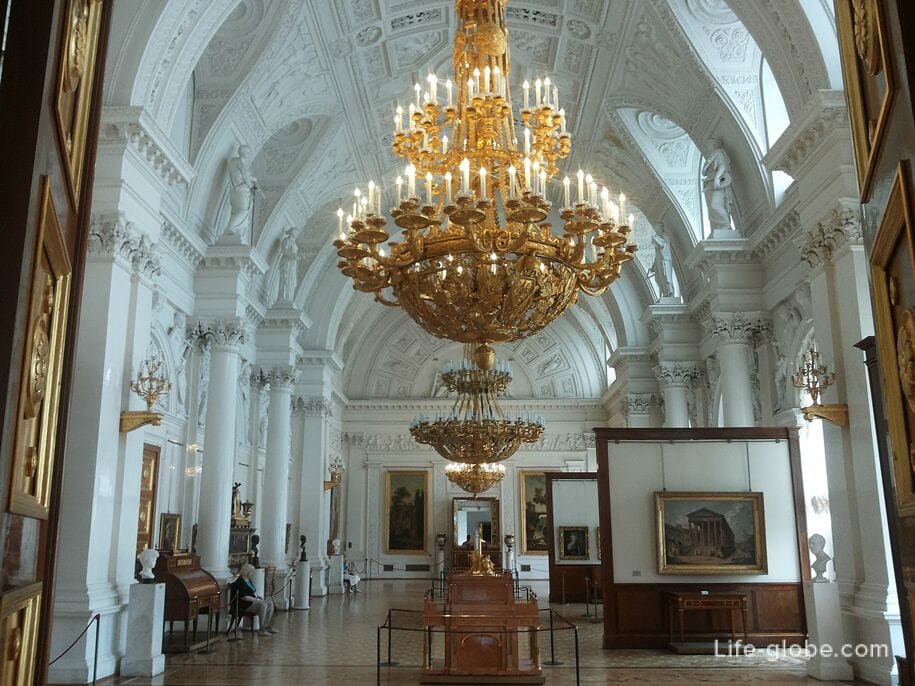
"The Crimson Study is Her Highness' so-called 'study', but it's basically a living room;
- and also: the Golden Drawing Room, the Great Church, the boudoir and other halls, offices and rooms of the Winter Palace, which now house the collections of the State Hermitage Museum.
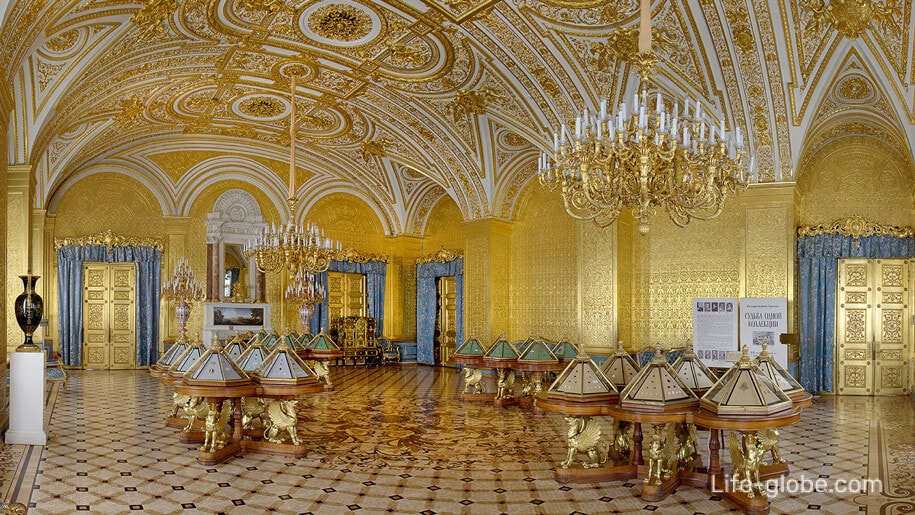

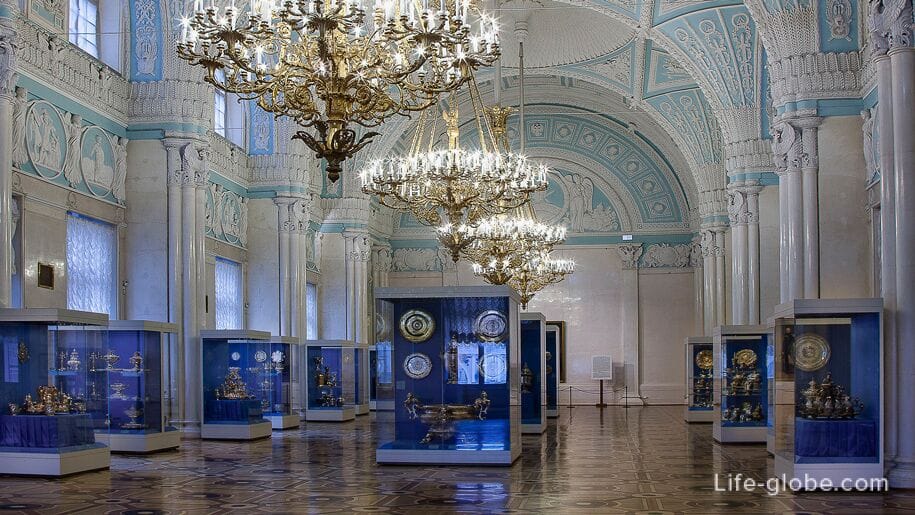
There are two routes through the main museum complex of the Hermitage:
- Route 1, when visiting which the Main Halls of the Winter Palace, as well as the expositions of the Old and New Hermitage are available first of all. This route should be chosen if you want to focus on visiting the Western European fine art and the Hermitage Art Gallery, as well as get acquainted with the ancient collections of the museum.;
- Route 2, where the Winter Palace halls are primarily accessible: the palace interiors and living quarters of the imperial family, permanent exhibitions of Russian culture and Eastern countries, as well as English and French art and numismatics. In the second part of this route, visitors will get acquainted with part of the main halls of the Winter Palace (from the Coat of Arms Hall) and with the Art Gallery and Ancient Art.
Attention! All additional information about the routes to the museum, halls and exhibitions, as well as opening hours, ticket prices and conditions for their purchase can be found on the official website of the State Hermitage Museum (the site is listed below).
Why the Winter Palace? The royal family also had summer residences, which were located outside the city and, in addition to the main buildings (palaces), had auxiliary buildings, small palace buildings and impressive territories (parks) - this is the Grand Palace (Peterhof) and the Catherine Palace in Tsarskoye Selo.
The Winter Palace is part of the State Hermitage Museum and is part of the main museum complex.
The entrance to the Winter Palace (Hermitage) is organized from the side of the Palace Square through the Large Courtyard of the Winter Palace.
Website of the State HermitageMuseum: hermitagemuseum.
The nearest metrostations are : "Admiralteiskaya" (650 meters), "Nevsky Prospekt" (1 kilometer), "Gostiny Dvor" (1.6 kilometers).
Ground stop: "Palace Square" (500 meters). Buses: 7, 10, 24, 191, trolleybuses: 1, 7, 10, 11.
You can also visit the Hermitage with one of the excursions
The State Hermitage Museum has an official 5-star hotel with an exquisite interior of the luxury of Tsarist Russia, which is located in a quiet part of the historical center of St. Petersburg in a building built in the mid-19th century.
The hotelhas a boutique restaurant, a restaurant, a lobby bar, a fitness center, a spa and wellness center and free Wi-Fi.
The rooms and suites are decorated with elegant furniture designed by Florentine woodworkers. Each room here will provide you with a flat-screen TV, a minibar and a private bathroom with Italian and Greek marble. Bathrobes are also provided.
Breakfast can be included in the room rate. Link to the hotel
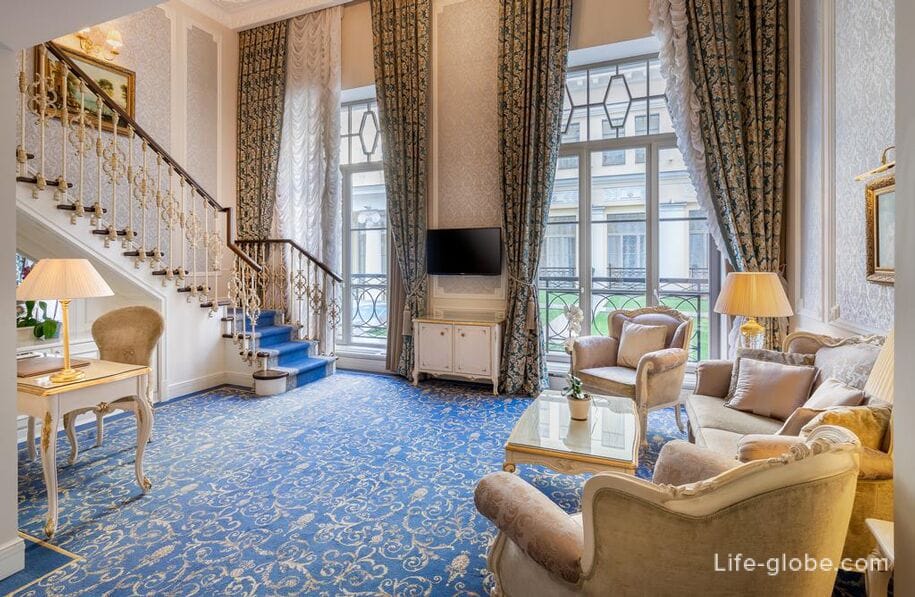
All accommodation facilities in Saint Petersburg, including in the city center and near the Winter Palace, can be viewed and booked here